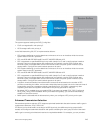
The system supports loading two DCB_Config files:
• FCoE converged traffic with priority 3.
• iSCSI storage traffic with priority 4.
In the Dell Networking OS, PFC is implemented as follows:
• PFC supports buffering to receive data that continues to arrive on an interface while the remote
system reacts to the PFC operation.
• PFC uses DCB MIB IEEE 802.1azd2.5 and PFC MIB IEEE 802.1bb-d2.2.
• PFC is supported on specified 802.1p priority traffic (dot1p 0 to 7) and is configured per interface.
However, only two lossless queues are supported on an interface: one for Fibre Channel over
Ethernet (FCoE) converged traffic and one for Internet Small Computer System Interface (iSCSI)
storage traffic. Configure the same lossless queues on all ports.
• PFC supports buffering to receive data that continues to arrive on an interface while the remote
system reacts to the PFC operation.
• PFC uses DCB MIB IEEE 802.1azd2.5 and PFC MIB IEEE 802.1bb-d2.2.
• PFC is supported on specified 802.1p priority traffic (dot1p 0 to 7) and is configured per interface.
However, only two lossless queues are supported on an interface: one for Fibre Channel over
Ethernet (FCoE) converged traffic and one for Internet Small Computer System Interface (iSCSI)
storage traffic. Configure the same lossless queues on all ports.
• A dynamic threshold handles intermittent traffic bursts and varies based on the number of PFC
priorities contending for buffers, while a static threshold places an upper limit on the transmit time of
a queue after receiving a message to pause a specified priority. PFC traffic is paused only after
surpassing both static and dynamic thresholds for the priority specified for the port.
• By default, PFC is enabled when you enable DCB. If you have not loaded FCoE_DCB_Config and
iSCSI_DCB_Config, DCB is disabled. When you enable DCB globally, you cannot simultaneously
enable link-level flow control.
• Buffer space is allocated and de-allocated only when you configure a PFC priority on the port.
Enhanced Transmission Selection
Enhanced transmission selection (ETS) supports optimized bandwidth allocation between traffic types in
multiprotocol (Ethernet, FCoE, SCSI) links.
ETS allows you to divide traffic according to its 802.1p priority into different priority groups (traffic
classes) and configure bandwidth allocation and queue scheduling for each group to ensure that each
traffic type is correctly prioritized and receives its required bandwidth. For example, you can prioritize
Data Center Bridging (DCB)
243


















